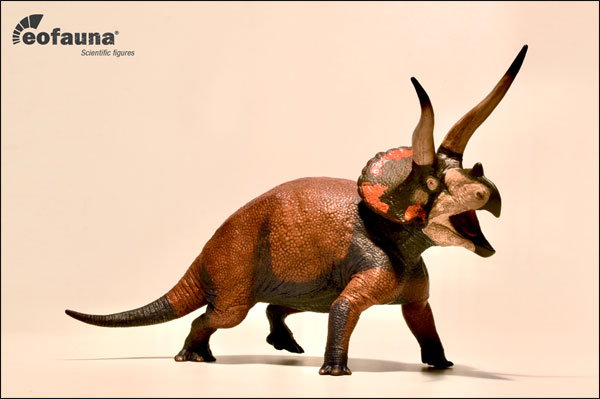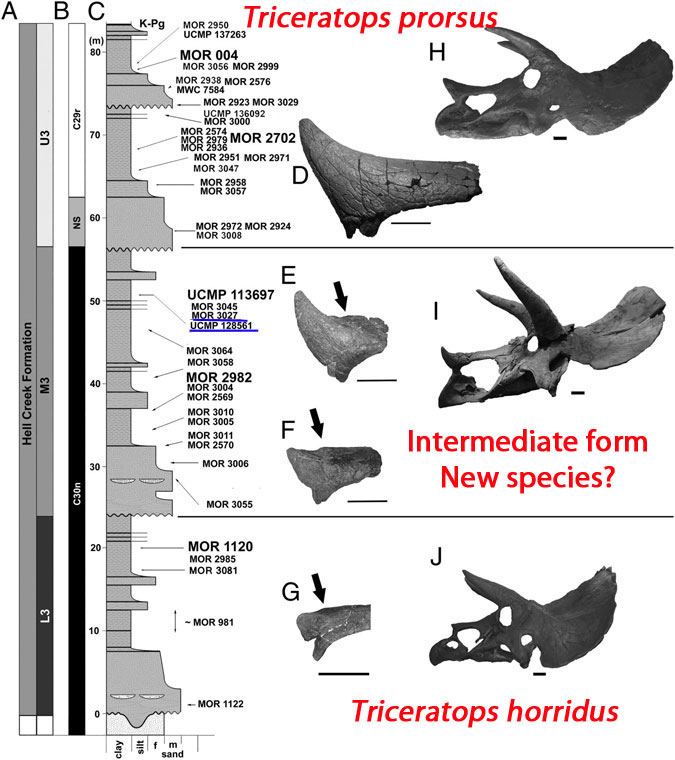Eofauna Announce a New Triceratops Species
Eofauna Announce a New Triceratops Species
The talented team at Eofauna Scientific Research in collaboration with Everything Dinosaur have revealed their latest prehistoric animal model. The sixth model in this exciting series is a replica of a Triceratops. It is not a model of Triceratops horridus or indeed T. prorsus, but a representation of a probable third species, one that has not yet been formally described.
This exciting new model is due to be in stock at Everything Dinosaur early in 2021.
The Eofauna Scientific Research Triceratops sp. Replica

Picture credit: Eofauna Scientific Research
Triceratops is a Confusing Taxa
“Three-horned Face” might be one of the best known of all the Dinosauria, but from a palaeontological perspective we have a lot to learn about this denizen of the famous Hell Creek Formation of North America. As many as sixteen different species of Triceratops have been recognised in the past, today, we have just two, Triceratops horridus and the geologically younger Triceratops prorsus. The new Eofauna Triceratops model is based on an, as yet, unnamed species that shows characteristics of both T. horridus and T. prorsus, not surprisingly really as its fossils are found in sediments below where Triceratops prorsus fossils are located and above the layers associated with Triceratops horridus.
A Teaser Image was Released by Eofauna and Everything Dinosaur Prior to the Formal Announcement
Picture credit: Eofauna Scientific Research
Confused? Here’s a brief outline of the science…
Identifying Different Species of Horned Dinosaur
The Ceratopsia provide palaeontologists with a bit of a headache (deliberate pun intended), when it comes to distinguishing species. Many species have been erected based on the shape of their skulls and their cranial ornamentation – spikes, horns and frills, but these features change as the animals grow and mature. Hence the long running debate as to whether Torosaurus is a distinct genus or merely very old examples of Triceratops. Working out species is often compounded when ideas relating to sexual dimorphism are incorporated into the mix.
How to Identify a New Species
In helping to identify a species, a number of conditions need to be met, such as:
1). The fossils thought to represent a single species need to come from closely associated stratigraphic layers and from the same area.
2). A range of specimens representing different individuals of different ages are required to help to rule out variations due to ontogeny (different stages of growth and maturity).
3). Ideally intermediate specimens should exist that combine features of older and younger related species within the stratigraphic column.
Stratigraphic Placement of Hell Creek Formation Triceratops

Picture credit: Scannella et al
The Eofauna Triceratops Figure
The new Eofauna Triceratops model has been inspired by fossil finds associated with the middle portion of the Hell Creek Formation (M3). The design team have incorporated findings from the study of Triceratops bones such as specimen number UCMP 128561 and MOR 3027 (underlined in blue on the diagram above), that reveal a suite of anatomical characteristics intermediate between T. horridus and T. prorsus.
Although the lower, middle and upper portions of the Hell Creek Formation cover a relatively short period of geological time (around 2 million years), extensive research has revealed that the two currently recognised species of Triceratops are separated stratigraphically and that over time, there was a transformation in the Triceratops lineage with T. horridus evolving into T. prorsus with an intermediate species stage. In biology, the gradual transition of one species into another within a population is referred to as anagenesis.
Our congratulations to Eofauna Scientific Research, we often praise model making companies for introducing new figures based on fossil specimens that have only recently been described, but in this case, Eofauna have gone further, they have produced a model of a dinosaur that has yet to be formally described demonstrating an informed perspective on vertebrate palaeontology.
To read Everything Dinosaur’s blog post from 2014 when the scientific paper was published: How Triceratops Got its Horns and Beak.
A Helpful Scientific Paper
For a comprehensive overview of the Triceratops genus in respect to identifying new species:
The scientific paper: “Evolutionary trends in Triceratops from the Hell Creek Formation, Montana” by John B. Scannella, Denver W. Fowler, Mark B. Goodwin and John R. Horner published in the Proceedings of the National Academy of Sciences USA.
The Eofauna Triceratops sp. model is due to be in stock at Everything Dinosaur in early 2021.
To view the current range of Eofauna models available from Everything Dinosaur: Eofauna Scientific Research Models and Figures.
In the meantime, visit the award-winning Everything Dinosaur website for prehistoric animals and dinosaur toys: Everything Dinosaur.


